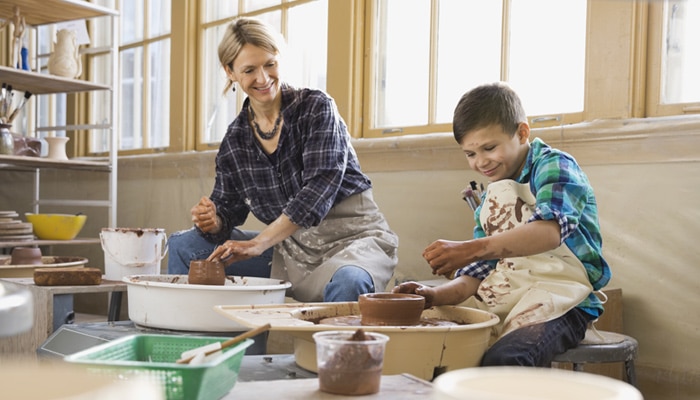While we believe that the books and resources recommended may be of value to you, keep in mind that these are suggestions only and you must do your own due diligence to determine whether the materials are appropriate and suitable for your use. PNC has no sponsorship or endorsement agreement with the authors or publishers of the materials listed.
MY FIVE SENSES

Ceramic Cups
Children will explore the sense of touch and will make a clay cup.

Lesson Objective
Children will explore the sense of touch using clay and will make a clay cup.
Arts
What You'll Need
- Air-dry clay – 1 tennis ball–sized piece per child
- Foam plates – 1 per child
- Waxed paper – enough to cover the baking sheet
- Baking sheet or large tray – 1
- A large, color reproduction or digital image of Cylinder Vase, Guatemalan, Mayan Culture – from the North Carolina Museum of Art’s website
What To Do
- Note: Prior to the start of the lesson, form a tennis ball–sized piece of clay for each child, place the balls on a waxed-paper–covered baking sheet or tray, and cover with a damp towel until ready for use.
- Introduce the artwork, and discuss (see Guiding Student Inquiry).
- Tell the children that they will explore the sense of touch using clay.
- Discuss the sense of touch (see Did You Know?).
- Place clay balls on plates, and distribute.
- Tell the children that they will need to manipulate their clay to warm it up. Demonstrate, and have the children follow along, rolling the clay into a ball.
- Discuss the texture of the clay (see Guiding Student Inquiry).
- Ask the children to name the important parts and features of a cup (tall sides, bottom, no holes).
- Demonstrate how to make a cup using the “pinch pot” method: Using your thumb, poke a hole in the center of the ball while keeping your fingers on the outside of the clay ball. Pinch the fingers to gradually make the hole bigger; at the same time, this will create the walls of the cup. Emphasize that the cup needs a bottom, so you don’t want to poke all the way through the center of the ball.
- Assist the children as necessary as they make their cups using the pinch pot method.
- As children finish, write names on plates, and place cups in an undisturbed location to dry.
- Have children wash their hands thoroughly.
- Take a gallery walk to look at the completed artwork. Encourage children to describe their cups and how they made them (see Guiding Student Inquiry).
Resources
Home School Resources
Home educators: use these printable lesson PDFs to teach this lesson to your home schoolers. They're available in English and Spanish.
Content Provided By
Common Core State Standards Initiative – These lessons are aligned with the Common Core State Standards ("CCSS"). The CCSS provide a consistent, clear understanding of the concepts and skills children are expected to learn and guide teachers to provide their students with opportunities to gain these important skills and foundational knowledge [1]. Visit the CCSS


